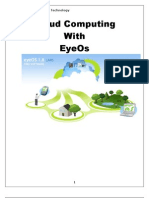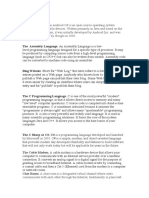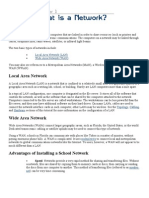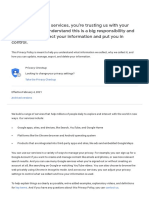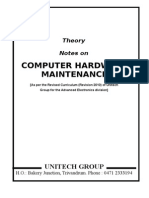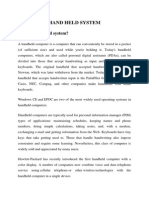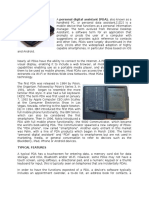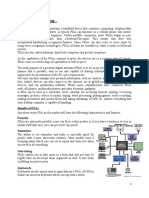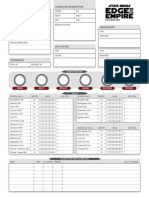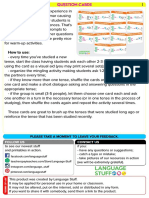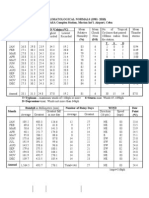Professional Documents
Culture Documents
Pda
Pda
Uploaded by
Sandeep PophaleOriginal Description:
Original Title
Copyright
Available Formats
Share this document
Did you find this document useful?
Is this content inappropriate?
Report this DocumentCopyright:
Available Formats
Pda
Pda
Uploaded by
Sandeep PophaleCopyright:
Available Formats
Personal Digital Assistants (PDA)
Introduction
Abstract
As microprocessors have become more capable at the same time as the cost has been reduced, the embedded systems market has been evolving too. Not too long ago, it was very common to see people creating new custom boards designed by an engineer to hold the processor, RAM, external devices and so on. This is still a fairly common practice even today, since a custom design will eliminate all unnecessary hardware to the bare minimums. The result is a very low cost design, which when manufactured in large enough quantities, offsets the initial design costs. As engineers get paid more and more however (sic), manufacturers are finding real benefits in using a standard computer design and only developing custom hardware that 'plugs-in' or 'wires-in' to the existing circuitry. Since there are only a limited number of microprocessor designs available, chip manufacturers have been forced to develop standards that can be adhered to for compatibility between devices. A good example of this is serial port driver chips. Today, many engineers find themselves working on a small-scale project that can't justify the time and expense to design the entire embedded system from scratch. Instead of devoting many hours of effort into designing a processor board complete with memory, controllers, refresh drivers, etc, many people will instead select a pre-designed computer and add on to the existing circuitry. Single board computers (SBC's) and personal digital assistants (PDA's) are the two most popularly used items involved in embedded programming today. Recent change in the embedded systems market is the introduction of the Personal Digital Assistant or PDA. While early PDA designs were geared mostly towards helping people track appointments, contacts and e-mail, newer designs are now appearing that include ways to expand the PDA's capabilities. Many PDA's include a compact flash memory slot that can be used to interface to hardware like modems, Ethernet adapters and more.
Personal Digital Assistants
A personal digital assistant (PDA), also known as a palmtop computer, or personal data assistant, is a mobile device that functions as a personal information manager. PDAs have the ability to connect to the Internet. A PDA has an electronic visual display, enabling it to include a web browser, have audio capabilities, enabling them to be used as mobile phones or portable media players. Many PDAs can access the Internet, intranets or extranets via Wi-Fi or Wireless Wide Area Networks. Many PDAs employ touchscreen technology.
The Birth of the PDA
Predecessors of the modern PDA include the Psion Organiser and the Sharp Wizard. These early devices, which were intended to be portable computers, came out in the mid- to late 1980s. They included small keyboards for input, a small display, and basic features such as an alarm clock, calendar, telephone pad and calculator. Support for specialized software such as games and spreadsheets was also included. The Psion Organiser II, released in 1986, was especially popular and more than half a million were sold. In 1993, Apple introduced the Newton MessagePad at a price of $700. It provided users with an electronic notepad, to-do list, calendar, telephone log and address file applications. Some of the Newton's innovations have become standard PDA features, including a pressure-sensitive display with stylus, handwriting recognition capabilities, an infrared port and an expansion slot. However, the Newton MessagePad was too big, expensive and complicated, and its handwriting recognition program was poor. Apple discontinued the Newton in 1998. The original PalmPilot was introduced in March of 1996 by Palm Computing (owned by U.S. Robotics at the time). It cost less than $300, ran on its own Palm operating system, fit in a shirt pocket and synchronized with consumers' PCs. The PalmPilot ran for weeks on AAA batteries, was easy to use, and could store thousands of contacts, appointments and notes. Part of its small size was due to the lack of a keyboard. Users used a stylus and the Graffiti language to input data. Not to be outdone, Microsoft had been working on various forms of portable computing, including PenWindows and tablet computers. In November 1996, Microsoft released Windows CE, its first operating system for mobile devices. A number of manufacturers, such as HP, Compaq and Casio, adopted it for what was dubbed the Handheld PC -- the first Windows-based competitor for the PalmPilot.
The term PDA was first used on January 7, 1992 by Apple Computer CEO John Sculley at the Consumer Electronics Show in Las Vegas, Nevada, referring to the Apple Newton. In 1996, Nokia introduced the first mobile phone with full PDA functionality, the 9000 Communicator, which grew to become the world's best-selling PDA. The Communicator spawned a new category of mobile phones: the "PDA phone", now called "Smartphone". Another early entrant in this market was Palm, with a line of PDA products which began with the March 1996 Pilot 1000. A handheld device that combines computing, telephone/fax, Internet and networking features. A typical PDA can function as a cellular phone, fax sender, Web browser and personal organizer. Unlike portable computers, most PDAs began as pen-based, using a stylus rather than a keyboard for input. This means that they also incorporated handwriting recognition features. Some PDAs can also react to voice input by using voice recognition technologies. PDAs of today are available in either a stylus or keyboard version. Today, almost all PDAs are smartphones. Over 150 million smartphones are sold each year, while "stand-alone" PDAs without phone functionality sell only about 3 million units per year. PDA's are a new area of embedded systems design that has become quite popular over few years PDAs are also called palmtops, hand-held computers and pocket computers
BLOCK DIAGRAM
PDA Features
A typical PDA has a touchscreen for entering data, a memory card slot for data storage, and IrDA, Bluetooth and/or Wi-Fi. However, some PDAs may not have a touch screen, using softkeys, a directional pad, and a numeric keypad or a thumb keyboard for input; this is typically seen on telephones that are incidentally PDAs. In order to have the functions expected of a PDA, a device's software typically includes an appointment calendar, a to-do list, an address book for contacts, a calculator, and some sort of memo (or "note") program. PDAs with wireless data connections also typically include an email client and aWeb browser.
Touch screen
Many of the original PDAs, such as the Apple Newton and Palm Pilot, featured a touchscreen for user interaction, having only a few buttonsusually reserved for shortcuts to often-used programs. some touchscreen PDAs, including Windows Mobile devices, had a detachable stylus to facilitate making selections. The user interacts with the device by tapping the screen to select buttons or issue commands, or by dragging a finger (or the stylus) on the screen to make selections or scroll. Typical methods of entering text on touchscreen PDAs include: A virtual keyboard, where a keyboard is shown on the touchscreen. Text is entered by tapping the on-screen keyboard with a finger or stylus. An external keyboard connected via USB, Infrared port, or Bluetooth. Some users may choose a chorded keyboard for one-handed use. Touchscreen PDAs intended for business use, such as the BlackBerry and Palm Treo, usually also offer full keyboards and scroll wheels or thumbwheels to facilitate data entry and navigation. Newer PDAs, such as the HTC HD2, Apple iPhone, Apple iPod Touch, and Palm Pre, Palm Pre Plus, Palm Pixi, Palm Pixi Plus,Google Android (operating system) include more advanced forms of touchscreen that can register multiple touches simultaneously. These "multi-touch" displays allow for more sophisticated interfaces using various gestures entered with one or more fingers.
Memory cards
Although many early PDAs did not have memory card slots, now most have either some form of Secure Digital (SD) slot or a CompactFlash slot. Although originally designed for memory, Secure Digital Input/Output (SDIO) and CompactFlash cards are available that provide accessories like Wi-Fi or digital cameras, if the device can support them. Some PDAs also have
a USB port, mainly for USB flash drives.Some PDAs use microSD cards, which are electronically compatible with SD cards, but have a much smaller physical size.
Wired connectivity
While early PDAs connected to a user's personal computer via serial ports or another proprietary connection, many today connect via a USB cable. PDAs are not typically able to connect to each other via USB, as USB requires one machine to act as a "host," which isn't a typical PDA function. Some early PDAs were able to connect to the Internet indirectly by means off an external modem connected via the PDA's serial port or "sync" connector,or directly by using an expansion card that provided an Ethernet port.
Wireless connectivity
Most modern PDAs have Bluetooth a popular wireless protocol for mobile devices. Bluetooth can be used to connect keyboards, headsets, GPS receivers, and other nearby accessories. It's also possible to transfer files between PDAs that have Bluetooth. Many modern PDAs have Wi-Fi wireless network connectivity, and can connect to Wi-Fi hotspots. All smartphones, and some other modern PDAs like the Apple iPod touch, can connect to Wireless Wide Area Networks, such as those provided by cellular telecommunications companies.
Synchronization
Most PDAs can synchronize their data with applications on a user's personal computer. This allows the user to update contact, schedule, or other information on their computer, using software such as Microsoft Outlook or ACT!, and have that same data transferred to PDAor transfer updated information from the PDA back to the computer. This eliminates the need for the user to update their data in two places. Synchronization also prevents the loss of information stored on the device if it is lost, stolen, or destroyed. When the PDA is repaired or replaced, it can be "re-synced" with the computer, restoring the user's data. Some users find that data input is quicker on their computer than on their PDA, since text input via a touchscreen or small-scale keyboard is slower than a full-size keyboard. Transferring data to a PDA via the computer is therefore a lot quicker than having to manually input all data on the handheld device.[citation needed]
Most PDAs come with the ability to synchronize to a computer. This is done through synchronization software provided with the handheld, or sometime with the computer's operating system. Examples of synchronization software include: HotSync Manager, for Palm OS PDAs Microsoft ActiveSync, used by Windows XP and older Windows operating systems to synchronize with Windows Mobile, Pocket PC, and Windows CE PDAs, as well as PDAs running iOS, Palm OS, and Symbian Microsoft Windows Mobile Device Center for Windows Vista, which supports Microsoft Windows Mobile and Pocket PC devices. Apple iTunes, used on Mac OS X and Microsoft Windows to sync iOS devices (such as the iPhone and iPod touch) iSync, included with Mac OS X, can synchronize many SyncML-enabled PDAs BlackBerry Desktop Software, used to sync BlackBerry devices These programs allow the PDA to be synchronized with a personal information manager, which may be part of the computer's operating system, provided with the PDA, or sold separately by a third party. For example, the RIM BlackBerry comes with RIM's Desktop Manager program, which can synchronize to both Microsoft Outlook and ACT!. Microsoft's ActiveSync and Windows Mobile Device Center only synchronize with Microsoft Outlook or a Microsoft Exchange server.
Third-party synchronization software is also available for some PDAs from companies like CommonTime and CompanionLink. Third-party software can be used to synchronize PDAs to other personal information managers that are not supported by the PDA manufacturers (for example,GoldMine and IBM Lotus Notes)
Wireless synchronization
Some PDAs can synchronize some or all of their data using their wireless networking capabilities, rather than having to be directly connected to a personal computer via a cable. Apple iOS devices, like the iPhone, iPod Touch, and iPad, can use Apple's MobileMe subscription service to synchronize calendar, address book, mail account, Internet bookmark, and other data with one or more Macintosh or Windows computers using Wi-Fi or cellular data connections.[10]
Palm's webOS smartphones primarily sync with the cloud. For example, if Gmail is used, information in contacts, email, and calendar can be synchronized between the phone and Google's servers. RIM sells BlackBerry Enterprise Server to corporations so that corporate BlackBerry users can wirelessly synchronize their PDAs with the company's Microsoft Exchange Server, IBM Lotus Domino, or Novell GroupWise servers. Email, calendar entries, contacts, tasks, and memos kept on the company's server are automatically synchronized with the BlackBerry
Automobile navigation
Some PDAs include Global Positioning System (GPS) receivers; this is particularly true of smartphones. Other PDAs are compatible with external GPS-receiver add-ons that use the PDA's processor and screen to display location information. PDA-based GPS can also display traffic conditions, perform dynamic routing, and show known locations of roadside mobile radar guns. TomTom, Garmin, and iGO offer GPS navigation software for PDAs.
Popular PDAs
BlackBerry HTC, especially the HTC P3470 (a.k.a. Pharos) I-mate Apple Inc. iPod touch, iPhone 2G, 3G, 4G, 4Gs Palm, Inc. smartphones under Palm OS Samsung Moment (TAB, NOTE, S version,etc) Android (Operating System) Tablet PCs
Technology used in PDAs
The Older three popular operating systems available for use on PDA devices. The PalmOS is probably the most widely used today, but others include Linux, Windows CE.NET, and Windows XP Embedded. Microprocessors and Memory
Like standard desktop and laptop computers, PDAs are powered by microprocessors. The microprocessor is the brain of the PDA, and it coordinates all of the functions according to programmed instructions. Unlikedesktop PCs and laptops, PDAs use smaller, cheaper microprocessors. Although these microprocessors tend to be slower than their PC counterparts, they're adequate for the tasks that PDAs perform. The benefits of small size and price outweigh the cost of slow speeds. A PDA doesn't have a hard disk. It stores basic programs (address book, calendar, memo pad and operating system) in a read-only memory (ROM) chip, which remains intact even when the machine shuts down. Your data and any programs you add later are stored in the device's randomaccess memory (RAM). Information in RAM is only available when the device is on. Due to their design, PDAs keep data in RAM safe because they continue to draw a small amount of power from the batteries even when you turn the device off. Less powerful PDAs have lower amounts of RAM. However, many application programs take up significant memory space, so most models have more memory. Also, Pocket PC devices generally require more resources and have even more RAM. To provide additional memory, many PDAs accept removable flash media add-on cards. These are handy for storing large files or multimedia content, such as digital photos. Some newer PDAs, such as the Palm Tungsten E2, use flash memory instead of RAM. Flash memory is non-volatile, which means it preserves the data and applications it stores -- even when all battery power is depleted.
Operating Systems
The operating system contains the pre-programmed instructions that tell the microprocessor what to do. The operating systems used by PDAs are not as complex as those used by PCs. They have fewer instructions, which require less memory. PDAs and smartphones typically have one of two types of operating systems: Palm OS or Windows Mobile. However, RIM makes a specific OS for its BlackBerrydevices, and the Symbian OS operates some smartphones.
Applications of PDAs
Medical Uses
Many companies have developed PDA products aimed at the medical profession's unique needs, such as drug databases, treatment information, and medical news. Services such as AvantGo translate medical journals into PDA-readable formats. WardWatch organizes medical records, providing reminders of information such as the treatment regimens of
patients to doctors making ward rounds. Pendragon and Syware provide tools for conducting research with, allowing the user to enter data into a centralized database using their PDA. Microsoft Visual Studio and Sun Java also provide programming tools for developing survey instruments on the handheld. These development tools allow for integration with SQL databases that are stored on the handheld and can be synchronized with a desktop- or server-based database. PDAs have been shown to aid diagnosis and drug selection and some studies[who?] have concluded that when patients use PDAs to record their symptoms, they communicate more effectively with hospitals during follow-up visits. The development of Sensor Web technology may lead to wearable bodily sensors to monitor ongoing conditions, like diabetes or epilepsy, which would alert patients and doctors when treatment is required using wireless communication and PDAs. PDAs are used in hospitals, hospices and care homes to record audit and surveillance data, and then sync with a remote data server for immediate access to management data and trend analysis. Kairos Systems (KAMPDA) is a complete audit and surveillance solution (EDCRS - Electronic Data Capture and Reporting Solution) allowing the user to record observations and rapidly disemminate feedback to nominated recipients, using the SoMo 650 PDA from Socket Mobile.
Educational Uses
As mobile technology becomes more common, it is increasingly being used as a learning tool. Some educational institutions have embraced M-Learning, integrating PDAs into their teaching practices. PDAs and handheld devices are allowed in many classrooms for digital note-taking. Students can spell-check, modify, and amend their class notes on the PDA. Some educators[who?] distribute course material through the Internet or infrared file-sharing functions of the PDA. Textbook publishers have begun to release e-books, or electronic textbooks, which can be uploaded directly to a PDA, reducing the number of textbooks students must carry. Software companies have developed PDA programs to meet the instructional needs of educational institutions, such as dictionaries, thesauri, word processing software, encyclopedias, and digital lesson planners.
Recreational uses
PDAs may be used by music enthusiasts to play a variety of music file formats. Many PDAs include the functionality of an MP3 player. Road rally enthusiasts can use PDAs to calculate distance, speed, and time. This information may be used for navigation, or the PDA's GPS functions can be used for navigation.
Underwater divers can use PDAs to plan breathing gas mixtures and decompression schedules using software such as "V-Planner." As of today, any smartphone can do this as well.
PDAs for people with disabilities
PDAs offer varying degrees of accessibility for people with differing abilities, based on the particular device and service. People with vision, hearing, mobility, or speech impairments may be able to use PDAs on a limited basis. This use may be enhanced by accessibility software (e.g., speech recognition for verbal input instead of manual input). Universal design is relevant to PDAs as well as other technology, and a viable solution for many user-access issues, though it has yet to be consistently integrated into the design of popular consumer PDA devices.
Advantages of PDA
Increased speed Portability Improved vocabulary Almost universally preferred for plays; split on novels; Disney World effect- small chunks of text are seen as more palatable and lends to a sense of accomplishment o Use of Calendar for organizing time o o o o
Disadvantages
Potential breakage/power loss Formatting can be lost Compatability easily broken if dropped screens easily scratched if used a lot easy to lose stylus for Palms limited video playback capability
Fragile and Delicate PDAs are not designed for rough use. They are delicate devices that are vulnerable to bumps, scratches and even fractures. Only a few specialized types are waterproof while most others are susceptible to failure if exposed to humidity. According to Peter Grego in the book "Astronomical Cybersketching," PDAs are prone to differences in temperature and shut down if they get too warm or too cold.
PDAs are susceptible to viruses, which can often erase and/or damage their contents. The Phage PDA virus, for instance, introduced in September 2004, infected programs and rendered them inactive. PDAs on mobile networks are vulnerable to attacks and Internet breaches by other devices on the same networks. An appropriate PDA protective case and an updated virus protection software can effectively manage these risks. Costs and Time Limitations PDAs are expensive. The typical costs associated with them include their cost of purchase and upgrades and cost of maintenance (servicing and batteries). According to Marc Mancini in the book "Time Management," PDAs are not always the most effective answer to business solutions. Paper-based organizers are a more viable option since PDAs are difficult to use, data entry is awkward, they are slow and novice users find them unnecessarily complex. Limited in Scope PDAs are limited in scope. They are neither laptop replacements nor can they be effectively used to replace cellular phones. PDAs are not equipped to deal entirely with micro-processing capabilities. Their display screens are small and most users find it difficult to navigate data on them. PDAs are limited in terms of memory and many require additional memory upgrades. According to Julie A. Jacko in the book "Human-Computer Interaction," tablet PCs provide better functions in terms of touchpanel navigation, battery capacity, handwriting recognition and storage. According to Agnes Kukulska-Hulme and John Traxler in the book "Mobile Learning," PDAs are not as powerful nor as convenient as other mobile devices and cannot replace entertainment and communications hardware, such as MP3 players. Costs In order for Personal Digital Assistants to have their full range of features, you will have to sign up for some kind of Internet data plan with your cell phone carrier. These data plans tend to cost upwards of $30 a month extra. While it may not sound like much at first, over the lifetime of a typical cell phone contract you are looking at paying $720 more than you would without a PDA. Lack of Privacy A potential drawback, at least for some people, is the lack of privacy you have when you have a PDA on your person. In addition to having people calling you at all hours of the day, PDAs now put your email in the palm of your hands. Unless you make the active decision to keep your PDA at home, you run the risk of being hassled by people all day.
Distractions Becasue your PDA is constantly connected to the Internet, it can be tempting to play around with your phone. Surfing the net, downloading and playing games, texting and general fiddling with your PDA can draw your attention from more important tasks, like work or driving. Addiction A survey conducted in 2008 showed that over 80 percent of PDA owners admitted that they check their phone before bed or when they wake up in the morning, and 35% stated that they would choose their PDA over their spouse. This kind of addictive behavior can be crippling for a person's personal and social life.
CONCLUSION
Computers are the guides to the Information Age. Over the years, they have assumed the role as administrators of data. People depend these appliances to dispense the information that runs their lives. They need it right away, right here, right now. Constant access to computers equals constant access to knowledge. As a result, these devices to go wherever people go. PDAs are the solution to this vision of ubiquitous
computing. These devices represent a new step in computer technology. On paper, their specifications are impressive. They are often equipped with RISC microprocessors and sophisticated touchscreens. PDAs arm themselves with software for personal information management, spreadsheets, databases, and more. These devices also possess various expandability and communications options. And, they are small enough to fit in an human hand. However, they still need to mature, evolve, and solve basic problems of function, hardware, input, and connectivity. Strikingly new technology has usually required a gradual and tulmultous growth curve before being accepted by the general public. PDAs are no different. But, eventually, they will fulfill their original purpose of being "all-knowing" and "all-doing" devices The PDA makes the life simpler dor a Human being, with its user friendly functions. Its also evident that this makes human being more vulnerable to dependency towarda the technology.
BIBLIOGRAPHY
www.Google.com
http://en.wikipedia.org/wiki/Personal_digital_assistant http://electronics.howstuffworks.com/gadgets/travel/pda.html
http://www.webopedia.com/TERM/P/PDA.html http://www.bamafolks.com/randy/students/embedded/SBC_PDA.html
You might also like
- Week 4 p3 Identity Cues On Your Most Loved BrandDocument2 pagesWeek 4 p3 Identity Cues On Your Most Loved BrandTanay MathukiaNoch keine Bewertungen
- Manual Limpido XC60 PH PolishDocument41 pagesManual Limpido XC60 PH PolishMateusz BNoch keine Bewertungen
- CH 10Document32 pagesCH 10Gaurav KarkiNoch keine Bewertungen
- DECATHLONDocument2 pagesDECATHLONApple DecanoNoch keine Bewertungen
- Enterprise Architecture Landscape Using TOGAF Framework For Offshore CompanyDocument11 pagesEnterprise Architecture Landscape Using TOGAF Framework For Offshore CompanyEdd AguaNoch keine Bewertungen
- Cloud Computing With EyeosDocument45 pagesCloud Computing With EyeosSumit Ahuja100% (1)
- 07-Module 5 - Implementing IPv4Document50 pages07-Module 5 - Implementing IPv4Anderson Lobo de SousaNoch keine Bewertungen
- Network Layer and Connectionless ServiceDocument17 pagesNetwork Layer and Connectionless ServiceArunNoch keine Bewertungen
- A System For Keyword-Based Searching in Databases: N.L. Sarda Ankur JainDocument18 pagesA System For Keyword-Based Searching in Databases: N.L. Sarda Ankur JainSomasundaram SekarNoch keine Bewertungen
- IT202-NQ2012-Stwkbk-Web Application (Basic) .pdf11 - 47 - 2013 - 02 - 07 - 55 PDFDocument51 pagesIT202-NQ2012-Stwkbk-Web Application (Basic) .pdf11 - 47 - 2013 - 02 - 07 - 55 PDFAnulisa DasNoch keine Bewertungen
- Samenvatting Oracle Sectie 1-3Document63 pagesSamenvatting Oracle Sectie 1-3BoDedeurwaerderNoch keine Bewertungen
- Database Client Installation Guide LinuxDocument84 pagesDatabase Client Installation Guide Linuxraiizii2Noch keine Bewertungen
- Data Communications PDFDocument146 pagesData Communications PDFPrakasam ArulappanNoch keine Bewertungen
- Internet Technology2Document36 pagesInternet Technology2sammydtechNoch keine Bewertungen
- MC Lecture NotesDocument101 pagesMC Lecture NotesMallesh ArjaNoch keine Bewertungen
- Department of Computer Science: Dual Degree Integrated Post Graduate ProgramDocument31 pagesDepartment of Computer Science: Dual Degree Integrated Post Graduate ProgramanimeshNoch keine Bewertungen
- Ernieexample2 PDFDocument117 pagesErnieexample2 PDFkksunNoch keine Bewertungen
- Activity VDocument6 pagesActivity VAvox EverdeenNoch keine Bewertungen
- XII STD - Economics EM Combined 11.03.2019 PDFDocument296 pagesXII STD - Economics EM Combined 11.03.2019 PDFMonika AnnaduraiNoch keine Bewertungen
- Chapter - 06 Corporate Governance: Page 1 of 26Document26 pagesChapter - 06 Corporate Governance: Page 1 of 26masuda sultanaNoch keine Bewertungen
- Installing and Configuring Ws 2012Document300 pagesInstalling and Configuring Ws 2012Roberto Torres H100% (3)
- CompDocument113 pagesCompzakibrant23Noch keine Bewertungen
- What Is A NetworkDocument27 pagesWhat Is A NetworkAdeel Ahmad100% (1)
- Basics of Computer and Computer TroubleshootingDocument15 pagesBasics of Computer and Computer Troubleshootingchibssa alemayehuNoch keine Bewertungen
- Chapter 2 Forms of Business OwnershipDocument18 pagesChapter 2 Forms of Business Ownershipwwl0% (1)
- 20410D ENU HandbookDocument552 pages20410D ENU HandbookMarina Zevallos ValentinNoch keine Bewertungen
- Machine Learning ToolboxDocument10 pagesMachine Learning ToolboxmlaijNoch keine Bewertungen
- What Is HackingDocument17 pagesWhat Is HackingShivam KabirNoch keine Bewertungen
- Soft Computing: Concepts and Techniques: January 2014Document17 pagesSoft Computing: Concepts and Techniques: January 2014Boubaker DouisNoch keine Bewertungen
- Mypc 1h Digital Photo Editing 2 HandoutDocument7 pagesMypc 1h Digital Photo Editing 2 Handoutapi-250224911Noch keine Bewertungen
- Summer Training Project Report: Prabath Financial Services LimitedDocument66 pagesSummer Training Project Report: Prabath Financial Services Limitedrahuljajoo100% (1)
- Vsphere Esxi Vcenter Server 601 Troubleshooting GuideDocument113 pagesVsphere Esxi Vcenter Server 601 Troubleshooting GuidesivakumarNoch keine Bewertungen
- Software EngineeringDocument284 pagesSoftware EngineeringJagatdeep SinghNoch keine Bewertungen
- CHAPTER TWO FM Mgt-1Document18 pagesCHAPTER TWO FM Mgt-1Belex Man100% (1)
- Notes FS Unit-1Document23 pagesNotes FS Unit-1Vishal GoyalNoch keine Bewertungen
- Class 9th Computer NotesDocument106 pagesClass 9th Computer Notesmochinkhan33% (6)
- Google Privacy Policy enDocument28 pagesGoogle Privacy Policy enMuhammad faisal Muhammad Faisal.MuhammadNoch keine Bewertungen
- Soft Computing: Concepts and Techniques: January 2014Document17 pagesSoft Computing: Concepts and Techniques: January 2014KANDI PAVANI (N140319)Noch keine Bewertungen
- Student Study Guide: Windows Server Administration FundamentalsDocument65 pagesStudent Study Guide: Windows Server Administration Fundamentalsnkshahane23Noch keine Bewertungen
- I and C Architecture DesignDocument65 pagesI and C Architecture DesignMvHHNoch keine Bewertungen
- NMLSbookDocument386 pagesNMLSbookejsimonsenNoch keine Bewertungen
- Principles of Corporate Taxation PDFDocument253 pagesPrinciples of Corporate Taxation PDFASIFNoch keine Bewertungen
- Microsoft Office 365 - Cloud in Business Environment: January 2012Document7 pagesMicrosoft Office 365 - Cloud in Business Environment: January 2012tvis MusicNoch keine Bewertungen
- Textbook of Introduction To EnvironmentaDocument134 pagesTextbook of Introduction To EnvironmentayadvinderNoch keine Bewertungen
- SW03Document11 pagesSW03Nadi HoodNoch keine Bewertungen
- Computer Hardware Maintenance 2010Document83 pagesComputer Hardware Maintenance 2010Aravind Bhombore100% (1)
- Difference Betwn Windows Linux and MacDocument12 pagesDifference Betwn Windows Linux and MacJagtar Singh100% (2)
- Learn Computer ScienceDocument24 pagesLearn Computer Sciencefabiobonadia100% (1)
- Project Report ON Computer NetworksDocument17 pagesProject Report ON Computer NetworksMithun DebnathNoch keine Bewertungen
- Eco 201Document133 pagesEco 201abonoNoch keine Bewertungen
- Database AssignmentDocument8 pagesDatabase AssignmentWidimongar JarqueNoch keine Bewertungen
- Course Objectives: PrerequisitesDocument12 pagesCourse Objectives: PrerequisitessandeepNoch keine Bewertungen
- Imperia+++++++L Leadership School Course OutlinesDocument25 pagesImperia+++++++L Leadership School Course Outlinesmuhammad100% (1)
- Hand Held SystemDocument20 pagesHand Held SystemJared AllenNoch keine Bewertungen
- A Personal Digital AssistantDocument7 pagesA Personal Digital AssistantsquidblitzNoch keine Bewertungen
- Personal Digital Assistants (P.D.A)Document17 pagesPersonal Digital Assistants (P.D.A)Ravi KrishnanNoch keine Bewertungen
- Smartphones and Pdas: Svits Quest-2007Document6 pagesSmartphones and Pdas: Svits Quest-2007BajiNoch keine Bewertungen
- Introduction To PDA: What's A Handheld PC (H/PC) ?Document19 pagesIntroduction To PDA: What's A Handheld PC (H/PC) ?dash_bani36Noch keine Bewertungen
- Pda'S Introduction:-: Benefits of Pdas PortableDocument11 pagesPda'S Introduction:-: Benefits of Pdas PortableZarnigar AltafNoch keine Bewertungen
- Computer AssignmentDocument7 pagesComputer AssignmentSyed Abrar Haider GillaniNoch keine Bewertungen
- Created By:-Shivam TutejaDocument14 pagesCreated By:-Shivam TutejaAtif KhanNoch keine Bewertungen
- Catagories of Computers: AssignmentDocument10 pagesCatagories of Computers: AssignmentaleezashiekNoch keine Bewertungen
- Module 1Document58 pagesModule 1Oscar KidegaNoch keine Bewertungen
- Novena Prayer To STDocument1 pageNovena Prayer To STCandypopNoch keine Bewertungen
- Brgy Pawa 2007 Sep 2007Document43 pagesBrgy Pawa 2007 Sep 2007Basho GunzNoch keine Bewertungen
- 15th Malaysia Education Fair 5-7 July 2023Document5 pages15th Malaysia Education Fair 5-7 July 2023Mohd Norhafifi Nor RahimNoch keine Bewertungen
- Quiz 3 - Fluids - IDDP - Google FormsDocument5 pagesQuiz 3 - Fluids - IDDP - Google FormsVej JuttNoch keine Bewertungen
- Chapter 3. Flow MeasurementDocument28 pagesChapter 3. Flow Measurementkondgulikomal09Noch keine Bewertungen
- Battery Management Systems Solution For Car ElectrificationDocument67 pagesBattery Management Systems Solution For Car ElectrificationAbdullah JanNoch keine Bewertungen
- Pin Code Door Lock System With ArduinoDocument21 pagesPin Code Door Lock System With ArduinoSagun ShresthaNoch keine Bewertungen
- Animal Fibers - Wool and SilkDocument20 pagesAnimal Fibers - Wool and SilkmscomputerNoch keine Bewertungen
- CN-Unit 1 Routing AlgorithmsDocument68 pagesCN-Unit 1 Routing AlgorithmsDaksha 2001Noch keine Bewertungen
- Class Assignment ExpDocument5 pagesClass Assignment ExpTifahNoch keine Bewertungen
- A Rapid Filtration Method For Harvesting Cell Cultture Grown in Cellbag Bio ReactorsDocument4 pagesA Rapid Filtration Method For Harvesting Cell Cultture Grown in Cellbag Bio ReactorsfreefreederNoch keine Bewertungen
- Tikal. Paleoecology of An Ancient Maya - NieizvDocument339 pagesTikal. Paleoecology of An Ancient Maya - NieizvzanthiagoNoch keine Bewertungen
- Business ServicesDocument11 pagesBusiness ServicesBhoomi KachhiaNoch keine Bewertungen
- Horses TeethDocument336 pagesHorses TeethFatih Yilmaz100% (1)
- Cigarette Butt Recycling and Processing: Presenters: Ankita Sehrawat (0191MBA011) Anoushka Alang (0191MBA012)Document9 pagesCigarette Butt Recycling and Processing: Presenters: Ankita Sehrawat (0191MBA011) Anoushka Alang (0191MBA012)Sakshi GoelNoch keine Bewertungen
- 0600 w16 QP 11 PDFDocument16 pages0600 w16 QP 11 PDFAhmed NaserNoch keine Bewertungen
- EotE Character SheetDocument2 pagesEotE Character SheetMichael KeyNoch keine Bewertungen
- Surgical Technology For The Surgical Technologist A Positive Care Approach 5th Edition Association of Surgical Technologists Test BankDocument14 pagesSurgical Technology For The Surgical Technologist A Positive Care Approach 5th Edition Association of Surgical Technologists Test Bankabnormalhumble35j4i100% (37)
- How To Use:: Language Stuff Language StuffDocument7 pagesHow To Use:: Language Stuff Language StuffAline UslarNoch keine Bewertungen
- ME LAB 1 Group 4 QuizDocument5 pagesME LAB 1 Group 4 QuizAbreo Dan Vincent AlmineNoch keine Bewertungen
- Prospectus: For Admission Intomds Courses Under Competent Authority Quota For The Academic Year 2020 - 2021Document38 pagesProspectus: For Admission Intomds Courses Under Competent Authority Quota For The Academic Year 2020 - 2021krishnaNoch keine Bewertungen
- Pag-Asa Climatological NormalsDocument2 pagesPag-Asa Climatological NormalsCebuDailyNews100% (1)
- Case Study Scarlet Fever Repaired)Document34 pagesCase Study Scarlet Fever Repaired)Reimark RabanalNoch keine Bewertungen
- Resume Rajkiran Updated - GenDocument4 pagesResume Rajkiran Updated - GenRaj KiranNoch keine Bewertungen
- Standart WeldingDocument68 pagesStandart WeldingEko Wahyu QrakerNoch keine Bewertungen
- Equal, Less and Greater Than SymbolsDocument10 pagesEqual, Less and Greater Than Symbolssteffy LoNoch keine Bewertungen
- Scene 1: An Awful DayDocument8 pagesScene 1: An Awful DayKhúc ĐạtNoch keine Bewertungen





